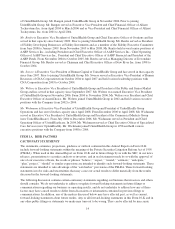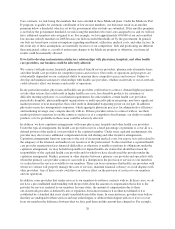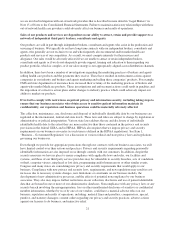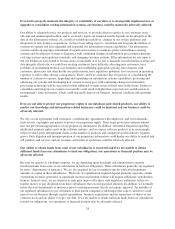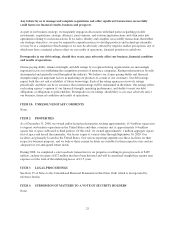United Healthcare 2008 Annual Report Download - page 25
Download and view the complete annual report
Please find page 25 of the 2008 United Healthcare annual report below. You can navigate through the pages in the report by either clicking on the pages listed below, or by using the keyword search tool below to find specific information within the annual report.assumptions we might make or by known or unknown risks and uncertainties. Many factors discussed below will
be important in determining future results. By their nature, forward-looking statements are not guarantees of
future performance or results and are subject to risks, uncertainties and assumptions that are difficult to predict or
quantify. Actual future results may vary materially from expectations expressed in this report or any of our prior
communications.
If we fail to effectively estimate, price for and manage our health care costs, the profitability of our risk-
based products could decline and could materially adversely affect our future financial results.
Under our risk-based product arrangements, we assume the risk of both medical and administrative costs for our
customers in return for monthly premiums. Premium revenues from risk-based products comprise approximately
90% of our total consolidated revenues. We generally use approximately 80% to 85% of our premium revenues
to pay the costs of health care services delivered to these customers. The profitability of our risk-based products
depends in large part on our ability to predict, price for, and effectively manage health care costs.
We manage health care costs through underwriting criteria, product design, negotiation of favorable provider
contracts and medical management programs. Total health care costs are affected by the number of individual
services rendered and the cost of each service. Our premium revenue on commercial policies is typically fixed
for a 12-month period and is generally priced one to four months before the contract commences. Our revenue on
Medicare policies is based on bids submitted in June the year before the contract year. We base the premiums we
charge and our Medicare bids on our estimate of future health care costs over the fixed contract period; however,
medical cost inflation, regulation and other factors may cause actual costs to exceed what was estimated and
reflected in premiums or bids. These factors may include increased use of services, increased cost of individual
services, catastrophes, epidemics, the introduction of new or costly treatments and technology, new mandated
benefits or other regulatory changes, insured population characteristics and seasonal changes in the level of
health care use. As a measure of the impact of medical cost on our financial results, relatively small differences
between predicted and actual medical costs or utilization rates as a percentage of revenues can result in
significant changes in our financial results. For example, if medical costs increased by 1% without a proportional
change in related revenues for commercial insured products, our annual net earnings for 2008 would have been
reduced by approximately $200 million.
In addition, the financial results we report for any particular period include estimates of costs that have been
incurred for which claims are still outstanding. These estimates involve an extensive degree of judgment. If these
estimates prove too low, they will have a negative impact on our future results.
If we fail to comply with federal and state regulations, or fail to respond quickly and appropriately to
health care reforms and frequent changes in federal and state regulations, our business, financial
condition and results of operations could be materially adversely affected.
Our business is regulated at the federal, state, local and international levels. The laws and rules governing our
business and interpretations of those laws and rules are subject to frequent change. The broad latitude that is
given to the agencies administering those regulations, as well as future laws and rules, could force us to change
how we do business, restrict revenue and enrollment growth, increase our health care and administrative costs
and capital requirements, and increase our liability in federal and state courts for coverage determinations,
contract interpretation and other actions. See Item 1, “Business – Government Regulation” for a discussion of
various federal and state laws and regulations governing our businesses.
We must obtain and maintain regulatory approvals to market many of our products, to increase prices for certain
regulated products and to complete certain acquisitions and dispositions, including integration of certain
acquisitions. Delays in obtaining approvals or our failure to obtain or maintain these approvals could reduce our
revenue or increase our costs.
Legislative proposals that would reform the health care system have been advanced by Congress and state
legislatures and are currently pending at the state and federal levels. These changes include policy changes that
15











